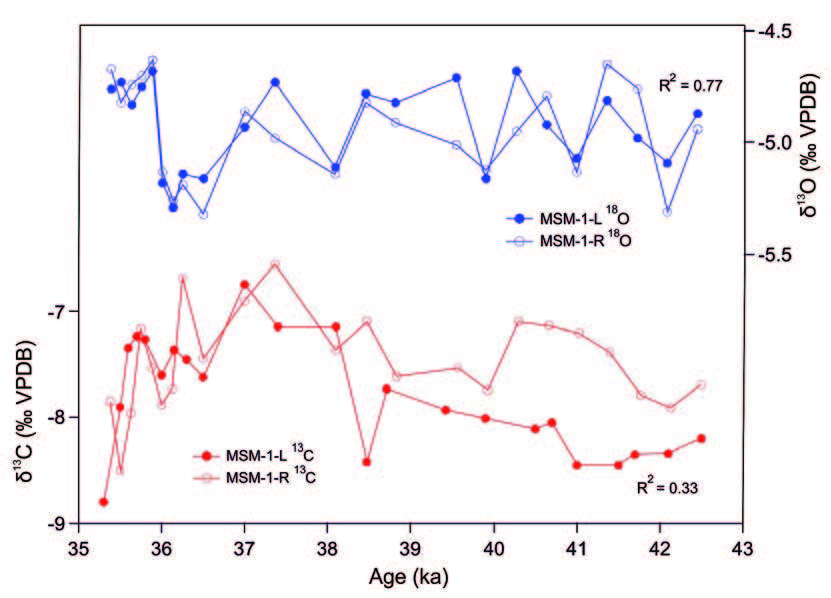Early and mid-holocene environmental conditions in the eastern Adriatic recorded in speleothems from Mala Špilja cave and Velika Špilja cave (Mljet island, Croatia)
DOI:
https://doi.org/10.3986/ac.v46i2-3.4939Keywords:
Holocene, speleothem, stable isotopes, Eastern Adriatic, CroatiaAbstract
This study presents high resolutionoxygen and carbon isotopic
record of two U-Th dated stalagmites from the Eastern
Adriatic caves. The stalagmites were collected from Mala špilja
and Velika špilja caves situated on Mljet Island in the southern
part of the Croatian Adriatic. Dripwater samples were
collected from Medvjeđa špilja, Strašna peć, Špilja u Vrdolje,
Kraljicina spilja, Velika špilja and Mala špilja caves. All caves
formed in well-stratified Cretaceous limestones. The average
value of deuterium excess of the dripwater is 9.3 ‰, indicating
that the atmospheric conditions over the Atlantic Ocean
have greater influence on the isotopic composition precipitation
in the Adriatic region than the Eastern Mediterranean
Sea. The longest isotopic record of the speleothems is of stalagmite
MSM-1 from Mala špilja Cave dated from 119.2
±3.3 ka to 5.6±0.6 ka, although deposition was not continuous.
During the Holocene the speleothem grew between 7 ka
and 4 ka. That interval is characterized by several δ18Oc and
δ13Cc fluctuations reflecting changes in the environment. Superimposed
on these fluctuations, there is an increasing trend
in the 7.0−6.5 ka interval, evident in elevated δ18O values,
which primarily refers the trend to drier conditions in the
eastern Adriatic, which were occasionally interrupted by wet
intervals. Humid conditions are particularly pronounced by
low δ18Oc and δ13Cc values of speleothem MSM-1 between 7.3
and 6 ka, as a reflection of increased precipitation and lower
temperatures. The transition to today's Mediterranean climate
(Cs) occurred between 6 ka and 5 ka, while the driest conditions
are recorded at ~4.7 − 4.2 ka. Comparisons between
the eastern Adriatic δ18Oc and δ13Cc records of the speleothem
from Mala špilja Cave (MSM-1) and Velika špilja Cave (Mljet
Island) with Soreq Cave (Israel) and Corchia Cave (Italy) together
with other proxies such as lake sediments demonstrate
that the speleothems from the Eastern Adriatic caves record
the local and the regional climatic changes.
Key words: Holocene, speleothem; stable isotopes; Eastern
Adriatic, Croatia.
Rekonstrukcija okoljskih razmer v
zgodnjem in poznem Holocenu na podlagi zapisa v sigi jam
Mala Špilja in Velika Špilja (otok Mljet, Hrvaška)
Raziskava temelji na visoko ločljivih zapisih kisikovih in ogljikovih
izotopov, pridobljenih iz dveh stalagmitov, datiranih z
uran-torijevo metodo. Kapnika sta bila vzorčena v jamah Mala
špilja in Velika špilja na otoku Mljet, v južnem delu hrvaškega
Jadrana. Vzorčena je bila tudi prenikla voda v jamah Medvjeđa
špilja, Strašna peć, Špilja u Vrdolje, Kraljicina spilja, Velika
špilja in Mala špilja. Vse omenjene jame so v plastovitem krednem
apnencu. Povprečna vrednost presežka devterija v prenikli
vodi je 9,3 ‰, kar kaže na prevladujoč podnebni vpliv
Atlantskega oceana v primerjavi z vplivom vzhodnega Sredozemlja.
Najdaljši izotopski zapis smo pridobili iz kapnika
MSM-1 iz Male špilje, katerega starost je med 119,2 ±3,3 ka in
5,6±0,6 ka. Za kapnik je značilnih več prekinitev izločanja. V
holocenu je kapnik rastel v obdobju med 7 ka in 4 ka. V tem
obdobju je več izrazitih nihanj δ18Oc in δ13Cc, kar kaže na spremembe
okolja. Med 7,0 in 6,5 ka je v zapisu trend naraščanja
δ18O, kar kaže na relativno suhe razmere v vzhodnem Jadranu,
ki so jih občasno prekinila vlažna obdobja. Med 7,3 in
6 ka je več obdobij z nizkim vrednostmi δ18Oc in δ13Cc v vzorcu
MSM-1, kar kaže na veliko padavin in nizke temperature.
Prehod v današnjo sredozemsko klimo (Cs) se je zgodil med
6 ka in 5 ka, najbolj suha obdobja smo zabeležili med 4,7 ka
in 4,2 ka. Primerjava izotopskih zapisov δ18Oc on δ13Cc iz Male
špilje (MSM-1) in Velike špilje (Mljet) z zapisi v jami Soreq (Izrael)
in v sistemu Corchia (Italija) ter drugimi kazalci nekdanjih
okolij, npr. jezerskimi sedimenti, kažejo, da sige vzhodne
ga Jadrana hranijo pomembne zapise o lokalnih in regionalnih
podnebnih spremembah.
Ključne besede: Holocen, siga, stabilni izotopi, vzhodni Jadran,
Hrvaška.
Downloads

Downloads
Published
How to Cite
Issue
Section
License
Authors guarantee that the work is their own original creation and does not infringe any statutory or common-law copyright or any proprietary right of any third party. In case of claims by third parties, authors commit their self to defend the interests of the publisher, and shall cover any potential costs.
More in: Submission chapter




